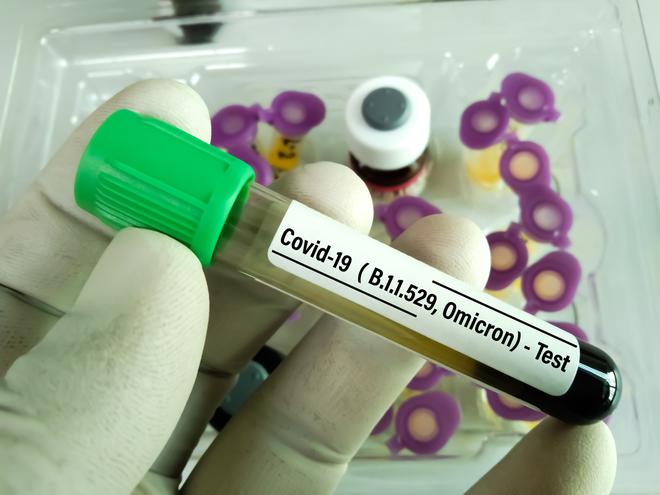Following in the footsteps of Omicron sub-lineage BA.1, which quickly spread to many countries and became the dominant strain in circulation after Omicron was designated as a variant of concern on November 26, 2021, the Omicron sub-lineage BA.2 is now following in the footsteps of BA.1 in many countries, including Denmark, the Philippines, and South Africa in recent weeks. This shows that the BA.2 sub-lineage has a “selection advantage” over the BA.1 sub-lineage, which is the original Omicron variation.
BA.1 and BA.2 Sequences grouped together
Dr. Emma Hodcroft, co-developer of Next Strain, stated that the BA.2 has a “cluster of sequences that share many of the same mutations as the ‘original’ Omicron (BA.1) but is missing certain mutations and has some new ones.”
Several studies are now showing that the BA.2 sub-lineage has an even higher proclivity for spreading among people and that it has the capacity to infect persons who have been fully vaccinated and/or previously infected by eluding neutralizing antibodies created by vaccination or infection.
A study was conducted on 24 people who had been fully vaccinated and had had a booster shot of the Pfizer vaccine, as well as eight people who had been spontaneously infected with SARS-CoV-2. There was a 23-fold and 27-fold drop in median neutralizing antibody titers to BA.1 and BA.2, respectively, in patients who had been fully vaccinated with the Pfizer vaccine compared to the Wuhan strain. On February 7, the findings were published on the medRxiv preprint server. Preprints haven’t been peer-reviewed yet.
Excellent defense
When compared to the Wuhan strain, the median neutralizing antibody titers to BA.1 and BA.2 were only 6.1-fold and 8.4-fold lower two weeks following a booster shot. BA.2 had around 1.4-fold lower neutralizing antibody titers than BA.1. In terms of public health, the study discovered that when vaccinated people were infected with BA.1, they developed strong anti-BA.2 antibodies. As a result, BA.1 infection in those who had been vaccinated provided good protection against BA.2.
The differences in protection against BA.1 and BA.2 in fully vaccinated and booster-shot recipients were insufficient to explain why BA.2 is spreading broadly in various parts of the world.
Resistance differences
Another study led by Dr. Dan H. Barouch of the Center for Virology and Vaccine Research in Boston, Massachusetts, demonstrated that both BA.1 and BA.2 can evade neutralizing antibodies in patients who are completely vaccinated or naturally infected. Using a panel of 19 neutralizing monoclonal antibodies as probes, the researchers discovered that BA.1, BA.2 repelled 17 of the 19 monoclonal antibodies completely or badly, but with several key peculiarities. BA.1 was more resistant to one type of antibody than BA.2, but BA.2 was more resistant to another type of antibody. On February 9, the findings were published as a preprint in bioRxiv sever.
“These findings have substantial public health implications,” Dr. Dan H. Barouch and colleagues write, “and suggest that the growing BA.2 frequency in the context of the BA.1 spike is likely attributable to greater transmissibility rather than enhanced immunologic escape.”
More contagious
Another study was done by Frederik Plesner Lyngse of the Danish Ministry of Health in Copenhagen, Denmark, found that unprotected, fully vaccinated, and those who had received a booster injection were more susceptible to infection by BA.2 than BA.1. BA.2 was, in short, more contagious than BA.1.
Surprisingly, “the relative increase in susceptibility was significantly greater in vaccinated individuals compared to unvaccinated individuals,” the researchers write. “This points to immune evasive properties of the BA.2 conferring an even greater advantage for BA.2 in a highly vaccinated population like Denmark.”
People infected with BA.2 who were not immunized were more transmissible than those infected with BA.1. People who had been fully vaccinated or who had received a booster injection, however, did not show this difference between BA.1 and BA.2. On January 30, this year, the findings were published on the preprint server medRxiv.
“We conclude that Omicron BA.2 is inherently more transmissible than BA.1 and that it also has immune-evasive properties that further reduce the protective effect of vaccination against infection, but do not increase its transmissibility from vaccinated individuals with breakthrough infections,” the Danish researchers write.
Experiments with hamsters
Another study published as a preprint on bioRxiv indicated that BA.2 had a stronger ability to proliferate in human nasal epithelial cells in cell culture, as well as a higher ability to fuse with cells. Infection studies with hamsters revealed that BA.2 is more pathogenic than BA.1, according to the authors.
Another Omicron sub-lineage, BA.3, was discovered in January. The spike protein contains 33 mutations. None of the mutations, however, are new. Thirty-one of the 33 mutations are also seen in BA.1, while the remaining two are found in BA.2. The BA.3 sub-lineage is distinguished by its slow spread when compared to BA.1 and BA.2. According to a BMJ report, one reason could be the absence of six mutations found in BA.1.

